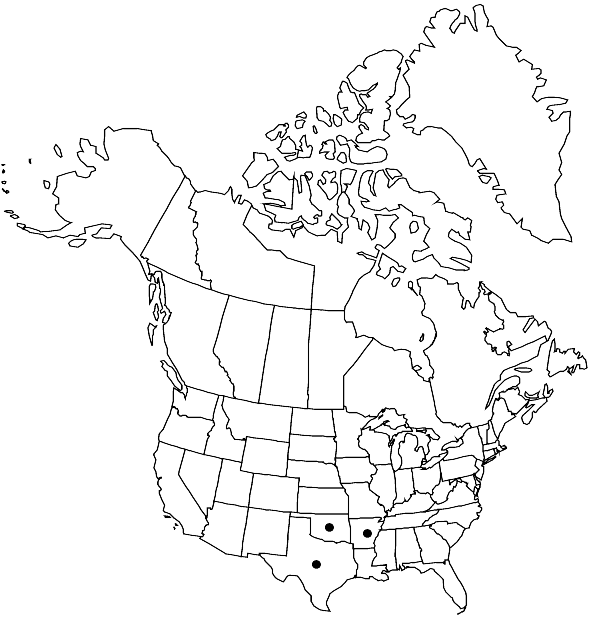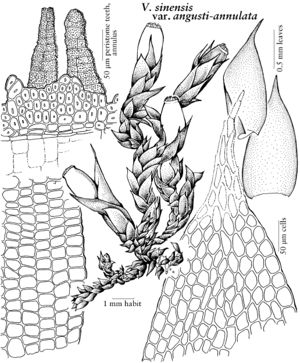Difference between revisions of "Venturiella sinensis var. angusti-annulata"
Phytologia 57: 58. 1985,.
FNA>Volume Importer |
imported>Volume Importer |
||
| (6 intermediate revisions by 2 users not shown) | |||
| Line 21: | Line 21: | ||
|elevation=moderate elevations | |elevation=moderate elevations | ||
|distribution=Ark.;Okla.;Tex. | |distribution=Ark.;Okla.;Tex. | ||
| − | |discussion=<p>In the flora area, Venturiella sinensis is known only from from Stone County in Arkansas, Blaine, Cherokee, Comanche, Payne, and Washita counties in Oklahoma, and Culberson County in Texas. G. J. Ikenberry et al. (1960) reported the species found on an elm tree near the campus of Oklahoma State University in Stillwater.</p><!-- | + | |discussion=<p>In the flora area, <i>Venturiella sinensis</i> is known only from from Stone County in Arkansas, Blaine, Cherokee, Comanche, Payne, and Washita counties in Oklahoma, and Culberson County in Texas. G. J. Ikenberry et al. (1960) reported the species found on an elm tree near the campus of Oklahoma State University in Stillwater.</p><!-- |
| − | --><p>Venturiella sinensis is the only Erpodiaceae in North America with a well developed peristome; the other species, Wildia solmsiellacea, occurs in Australia and New Caledonia. D. G. Griffin and A. J. Sharp (1971) in a comparison of North American and Asian collections of V. sinensis recognized two varieties, based primarily on a difference in the width of the annuli (57–69 µm in North American specimens vs. 69–129 µm in Asian specimens). In addition, the annular cells of North American plants are quadrate to octagonal while in the Asian plants the distal tiers of annular cells are usually ellipsoidal to rhomboidal.</p> | + | --><p><i>Venturiella sinensis</i> is the only Erpodiaceae in North America with a well developed peristome; the other species, Wildia solmsiellacea, occurs in Australia and New Caledonia. D. G. Griffin and A. J. Sharp (1971) in a comparison of North American and Asian collections of <i>V. sinensis</i> recognized two varieties, based primarily on a difference in the width of the annuli (57–69 µm in North American specimens vs. 69–129 µm in Asian specimens). In addition, the annular cells of North American plants are quadrate to octagonal while in the Asian plants the distal tiers of annular cells are usually ellipsoidal to rhomboidal.</p> |
|tables= | |tables= | ||
|references= | |references= | ||
| Line 31: | Line 31: | ||
-->{{#Taxon: | -->{{#Taxon: | ||
name=Venturiella sinensis var. angusti-annulata | name=Venturiella sinensis var. angusti-annulata | ||
| − | |||
|authority=Griffin | |authority=Griffin | ||
|rank=variety | |rank=variety | ||
| Line 45: | Line 44: | ||
|publication year= | |publication year= | ||
|special status= | |special status= | ||
| − | |source xml=https:// | + | |source xml=https://bitbucket.org/aafc-mbb/fna-data-curation/src/2e0870ddd59836b60bcf96646a41e87ea5a5943a/coarse_grained_fna_xml/V27/V27_690.xml |
|genus=Venturiella | |genus=Venturiella | ||
|species=Venturiella sinensis | |species=Venturiella sinensis | ||
Latest revision as of 21:27, 5 November 2020
Plants irregularly branched, in dense mats. Leaves to 1.2 mm; laminal cells smooth, distal cells rhomboidal, 38–57 × 15–18 µm, proximal cells quadrate to oblate in several marginal rows. Perichaetial leaves ovate, long-acuminate. Seta short, 0.5 mm. Capsule 1.5–1.8 mm; annulus narrow, 57–69 µm wide, in 4 rows of quadrate to octagonal cells. Calyptra 0.6 mm. Spores 21–30 µm.
Habitat: Dry areas on trunks and limbs of trees
Elevation: moderate elevations
Distribution

Ark., Okla., Tex.
Discussion
In the flora area, Venturiella sinensis is known only from from Stone County in Arkansas, Blaine, Cherokee, Comanche, Payne, and Washita counties in Oklahoma, and Culberson County in Texas. G. J. Ikenberry et al. (1960) reported the species found on an elm tree near the campus of Oklahoma State University in Stillwater.
Venturiella sinensis is the only Erpodiaceae in North America with a well developed peristome; the other species, Wildia solmsiellacea, occurs in Australia and New Caledonia. D. G. Griffin and A. J. Sharp (1971) in a comparison of North American and Asian collections of V. sinensis recognized two varieties, based primarily on a difference in the width of the annuli (57–69 µm in North American specimens vs. 69–129 µm in Asian specimens). In addition, the annular cells of North American plants are quadrate to octagonal while in the Asian plants the distal tiers of annular cells are usually ellipsoidal to rhomboidal.
Selected References
None.
